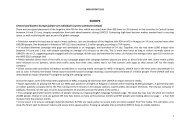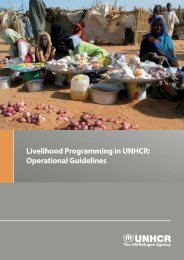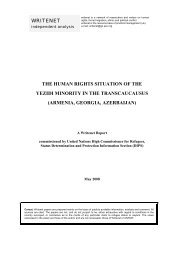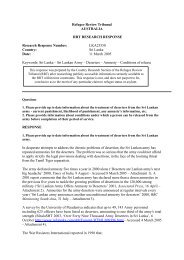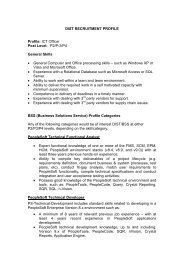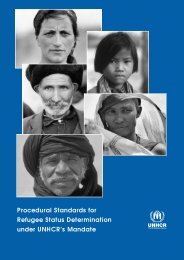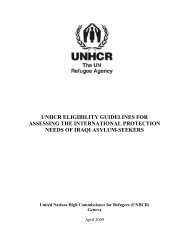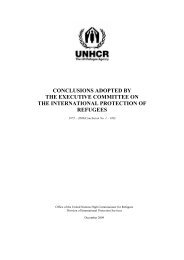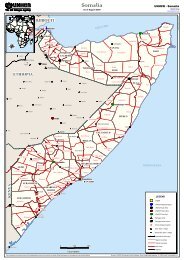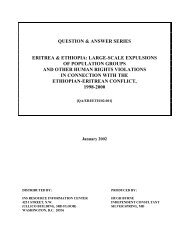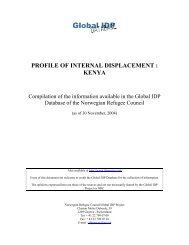UNHCR's ELIGIBILITY GUIDELINES FOR ASSESSING THE ...
UNHCR's ELIGIBILITY GUIDELINES FOR ASSESSING THE ...
UNHCR's ELIGIBILITY GUIDELINES FOR ASSESSING THE ...
You also want an ePaper? Increase the reach of your titles
YUMPU automatically turns print PDFs into web optimized ePapers that Google loves.
approach would also include those who had previously presented asylum claims and whose<br />
claims had been rejected. They should be permitted to submit new claims, and their claims<br />
should be examined accordingly.<br />
1. Well-Founded Fear of Persecution<br />
The refugee definition of the 1951 Convention contains both a subjective and an objective<br />
element. The former refers to an individual’s fear of harm in the event of return to the<br />
country of origin or, in the case of a stateless person, the country of habitual residence. The<br />
objective element refers to the applicant’s fear being well-founded, which means that there<br />
is a reasonable likelihood that the harm feared or some other form of harm would<br />
materialize upon return. 723<br />
Whether or not an applicant’s fear is well-founded must be assessed in the context of the<br />
situation in the country of origin, taking into account the personal profile, experiences and<br />
activities of the applicant which would put him or her at risk. While having been subjected<br />
to persecution or mistreatment in the past would normally indicate that the applicant<br />
continues to be at risk of some form of harm in the future, this is not a precondition for<br />
recognition as a refugee. 724 Additionally, the experiences of others, such as friends,<br />
relatives or persons in a similar situation as the applicant or of the same ethnic, religious or<br />
social group, may also show that the applicant’s fear of becoming a victim of the harm is<br />
well-founded. 725<br />
The 1951 Convention does not define “persecution”. However, it may be inferred from<br />
Article 33(1) of the 1951 Convention that a threat to life or freedom on account of race,<br />
religion, nationality, political opinion or membership of a particular social group constitutes<br />
persecution, as would other serious violations of human rights for the same reasons. 726 Yet,<br />
the scope of persecution should not be defined solely in terms of existing codified human<br />
rights standards. Other kinds of serious harm or treatment, may also amount to<br />
persecution. 727 Severe discrimination could also amount to persecution, in particular where<br />
livelihood is threatened. Measures which are not of a serious character by themselves, may<br />
amount to persecution on a cumulative basis.<br />
In the context of Central and Southern Iraq where extreme violence and acts of serious<br />
human rights violations by state and non-state actors is rife, the overall situation is such that<br />
there is a likelihood or reasonable possibility of serious harm. While there are reports that<br />
widespread human rights violations are perpetrated by the authorities including through use<br />
of militias, large numbers of religious and political groups commit extreme forms of<br />
723<br />
See UNHCR, Handbook on Procedures and Criteria for Determining Refugee Status under the 1951<br />
Convention and the 1967 Protocol relating to the Status of Refugees, HCR/IP/4/Eng/Rev.1, UNHCR 1979,<br />
Reedited, Geneva, January 1992, para. 37-41, available in UNHCR’s Refworld at: http://www.unhcr.org/cgibin/texis/vtx/refworld/rwmain?docid=3ae6b3314<br />
(further: “UNHCR, Handbook”).<br />
724<br />
Ibidem, para. 45.<br />
725<br />
Ibidem, para. 43.<br />
726<br />
Ibidem, para. 51. The requirement of a link with a Convention ground is discussed below at “Link With a<br />
1951 Convention Ground”.<br />
727<br />
See UNHCR, Handbook, para. 51, see above footnote 723.<br />
134




